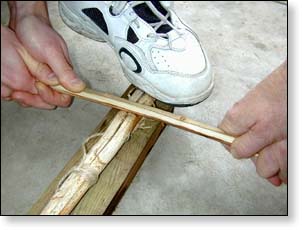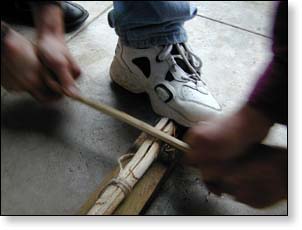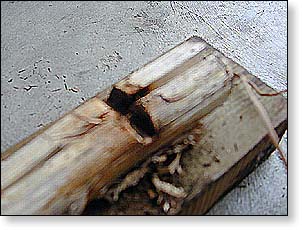
There are at least two different methods used by the Aboriginal people of Australia to start fires. This article describes them. Australian Aborigines are one of the few remaining cultural groups which are still familiar with their traditional subsistence methods.
I had always wondered what methods were used by indigenous people who habitually start a fire by friction protected their fire sticks from moisture. This would be particularly relevant in the Northern Territory where 6 months out of each year there are monsoon rains on a daily basis. On a recent trip to Australia my wife and I saw young Aboriginal men (Remember, in Australia 'abo' is a pejorative) at the Tjakupai Cultural Center in the Northern Territory start a fire with a hand-spun drill. They had a nicely made little case, covered with some sort of bark and resin and decorated with red seeds. The business end of the spindle and the hearthboard were protected by this cover. The entire assembly was then leaned, case up, against a tree. Only the parts which needed protection from the elements were protected.
It was clear that most of the Aboriginal men I spoke with in the NT were familiar with starting a fire with a hand drill. That does not mean they were always successful. At a cultural center in Darwin, NT, I asked a man if he had a set of traditional Aboriginal fire sticks and was willing to trade them for a set which I had brought from California. He went to his truck and brought out a spindle and hearthboard but said they belonged to his cousin so they were not available for trading. How many people keep a friction fire set in their vehicle? Of course he had to demonstrate how they worked. He apologized, saying that an essential ingredient was missing. He didn't have any dried kangaroo poo to put in the notch and catch the ember. He promptly assumed the position and stared twirling the spindle. Smoke and sweat but no ember. I know the feeling. Then a mate of his took over. Still no glowing ember. After a couple of blisters they gave up. Examination of the spindle and hearthboard showed that they were made from fairly dense wood. That means that much more energy would have to be applied to them to achieve ignition. Lower density materials with commensurate lower thermal capacity and conductivity require less energy to achieve ignition. Not being the mesomorphic (muscular) type I have to choose materials very carefully when I try to start a hand drill fire.

In the central desert of Australia a different fire-by-friction method is used. This was described very clearly by Richard A. Gould in his book "Yiwara: Foragers of the Australian Desert", ISBN684-71787-5, published in 1960 by Charles Scribner's Sons. "A branch is split and placed on the ground and thin wedges are inserted to hold the crack open and 'nail' the branch to the ground. One man stands astride the branch to hold it down while another places bits of dry kangaroo dung in the crack and lays the edge of his spearthrower across the branch at a point directly above the dry dung. He holds one end of the spear thrower and a third man kneels and takes hold of the other end. The two men saw vigorously back and forth with the spearthrower, working between the standing man's legs. In about twenty seconds a faint wisp of smoke appears from the dung inside the crack and the men stop sawing and begin to blow on the smoldering dung, adding bits of dry grass to it as tinder. The faint glow spreads until the tinder is alight and the burning tinder is carried around to light the four fires."
Lynn Weise, Monte Boyd, Emilio Lanier and I successfully started a fire using this device, hereby dubbed the Aboriginal fire saw at one of our Tuesday night flintknapping sessions. Lynn supplied a yucca stalk (unknown species but fairly hard, solid) from New Mexico and I brought a piece of split black cottonwood (Populus trichocarpa) to use instead of a spearthrower. These materials are among the most reliable choices for fire-by-friction with either a hand drill, bow drill or Polynesian fire plow. We split the yucca stalk and separated the two halves with a small wad of shredded cattail leaf. Emilio and Monte stood on either end of the split yucca. Our initial attempt didn't work because there was very little friction between the saw and the outer surface of the yucca. We next cut a small notch with a knife into the yucca where the saw rubbed back and forth. This improved the situation considerably and there was an apparently much higher coefficient of friction. A minor effort gave profuse smoke but no ember. The final modification was to push the wad of shredded cattail fiber down further so it was not in contact with the saw. Success! A moderate effort by the two sawyers produced plenty of smoke. We saw a tiny wisp of smoke coming up from inside the accumulation of powder. Gentle blowing caused it to get brighter. From here it would be an easy matter to transfer it to a handful of dry tinder and create a flame.
An alternate method, involving only two persons, would be to have the two persons kneel on one knee on opposite sides of the split stick. Their forward foot would be placed on the split stick to hold it securely. In this manner two persons could simultaneously hold the split stick down and do the sawing.
Why should one choose one fire-by-friction method over another? Better yet, why would one group of indigenous people select a particular method? What materials are available? What are the human resources available? What are the climatic conditions under which they must work? What tools are available for fashioning the parts? Beats me. The Aboriginal fire saw requires very little in the way tools for construction since it involves only rough cutting and splitting and no precision operations. The method has two advantages for a classroom situation. It is a joint effort. Consequently it can be used to teach the advantages of teamwork and cooperation. The physical efforts of at least two persons are combined. Consequently two people who are not terribly muscular can achieve a friction fire when neither could do it individually. This is important for teaching stone age skills to young people or the weaker sex, whichever one that is. The second reason for teaching it is that it is a method which requires no tools. Give it a try.


E-mail your comments to "Richard A. Baugh" at richardbaugh@att.net
E-mail questions answered
about fire-by-friction.
We hope the information on the PrimitiveWays website is both instructional and enjoyable. Understand that no warranty or guarantee is included. We expect adults to act responsibly and children to be supervised by a responsible adult. If you use the information on this site to create your own projects or if you try techniques described on PrimitiveWays, behave in accordance with applicable laws, and think about the sustainability of natural resources. Using tools or techniques described on PrimitiveWays can be dangerous with exposure to heavy, sharp or pointed objects, fire, stone tools and hazards present in outdoor settings. Without proper care and caution, or if done incorrectly, there is a risk of property damage, personal injury or even death. So, be advised: Anyone using any information provided on the PrimitiveWays website assumes responsibility for using proper care and caution to protect property, the life, health and safety of himself or herself and all others. He or she expressly assumes all risk of harm or damage to all persons or property proximately caused by the use of this information.
© PrimitiveWays 2013